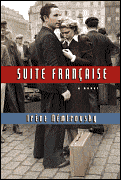
In 1941, Irene Nemirovsky sat down to write a book that would convey the magnitude of what she was living through, not in terms of battles and politicians, but by evoking the domestic lives and personal trials of the ordinary citizens of France. She did not live to see her ambition fulfilled, or to know that sixty-five years later, Suite Francaise would be published for the first time, and hailed as a masterpiece.
Set during a year that begins with France's fall to the Nazis in June 1940 and ends with Germany turning its attention to Russia, Suite Francaise falls into two parts. The first is a brilliant depiction of a group of Parisians as they flee the Nazi invasion and make their way through the chaos of France; the second follows the inhabitants of a small rural community under occupation who find themselves thrown together in ways they never expected. Nemirovsky's brilliance as a writer lay in her portrayal of people, and this is a novel that teems with wonderful characters, each more vivid than the next. Haughty aristocrats, bourgeois bankers and snobbish aesthetes rub shoulders with uncouth workers and bolshy farmers. Women variously resist or succumb to the charms of German soldiers. However, amidst the mess of defeat, and all the hypocrisy and compromise, there is hope. True nobility and love exist, but often in surprising places.
Irene Nemirovsky conceived of Suite Francaise as a four- or five-part novel. It was to be a symphony - her War and Peace. Although, only two sections were finished before her tragic death, they form a book that is beautifully complete in itself, and awe-inspiring in its understanding of humanity.
This was a very good read. The two sections that are included in this novel are called Storm in June and Dolce. The first part focuses on the experience of those people who fled Paris in front of the German occupation of France. Many of the people who fled were killed as the roads and railways they were using to escape were bombed, and Nemirovsky's words evoke the panic and the desperation of the people as they search for food and accommodation. During this first part we are introduced to several distinct characters, or groups of characters, providing a framework for a sharp commentary on the social classes of the time, from the very rich and powerful, to the bourgeois artists, middles classes and the poor. At first it seems like there is no connection at all between all these different groups but as the novel progresses, especially into the second section you see how gradually the author ties the characters together. Many of the survivors of this exodus ended up back in Paris after harrowing experiences.
The second part of the novel focuses on a small town that has been occupied by the Germans, and how the townspeople cope with that. At first there is a frosty wall built against the Germans, but gradually they become part of the town, with some of the women falling in love with German soldiers, with bottles of wine shared around the meal table, until it is time for the garrison of troops to move out to a new theatre of war. One of the German officers is a particularly well written character - giving a very human face where it would be so easy to portray a villainous, cold and uncaring conqueror.
The book is incredibly descriptive, and at times the story drags a little bit because of it, but what is conveyed through the words and pages is the immediacy of the situation. This is not some scene imagined from the newsreels. These kind of situations were what the author was actually living, which makes it all the more poignant to read about her characters and their experiences. Many of the characters are flawed, particularly the artists and the upper classes. In some ways, the story almost feels like a study of the priorities in our lives. When the characters are fleeing Paris, what are the things that are valued amongst all others - a collection of china, manuscripts, linen, the family silverware, and yet by the end of the journey for some of the characters there will be a reassessing of those priorities. For others though, there is not, although it has to be said that looking through the appendices it seemed that their changes may have been intended to be more long term.
In some ways these two parts of the book do feel complete, but there are others where it was obvious that there was more to come. There was at least one character that was introduced that there was no further development with, and there were events that were left unresolved, but for the most part it doesn't really affect the enjoyment of the book.
For all that is said about the book though, it may be that the story OF the book is as interesting, and maybe even more interesting, than the story IN the book. Irene Nemirovsky was a successful author of Russian Jewish descent, who moved to France during the Russian Revolution, with her family losing all their fortune. In 1939, she and her family converted to Catholicism in the hope that this would protect them. She started this book in 1941, and published as an appendix to the book are the notes that she had written which give some idea of the direction that she wanted to take and her thoughts during this time. Before she could complete the four or five parts to the book, she was arrested, taken to Auschwitz and never heard from again.
In some ways, the second appendix is even more poignant. It features a series of correspondence between the author and some of her friends and colleagues, in the time leading up to the Occupation, showing her fears for her own wellbeing, and that of her family. The tone of the letters change after her arrest, as her husband and friends try to find out where she has gone, to intercede on her behalf. At one point her husband even offers to trade himself for her, not realising that at time she was already dead.
Her children only just managed to escape the authorities several times, not realising that amongst their luggage was the manuscript for this book. It was only after many years that her daughters could bring themselves to read it, so this book that was first written in 1941 was only just published in France in 2004.
For me, this was a very poignant read, and well worth taking the time and making an effort to read, even though at times it felt overly descriptive.
Rating 4/5
Other Book Blogger's thoughts:
You Can Never Have Too Many Books
One More Chapter
The Inside Cover







This book looks soooo good!
ReplyDeleteGood review Marg, will definatly give it a second chance! Vez
ReplyDeleteI was going to say to you to leave a comment!!
ReplyDeletetee hee!
ReplyDeletev
Thanks so much for adding my review! I've just added you to mine, thanks for sending me your link also. It was a really poignant book, as you say so well in your review. I will probably read it again, it is something worth returning to, I think.
ReplyDelete